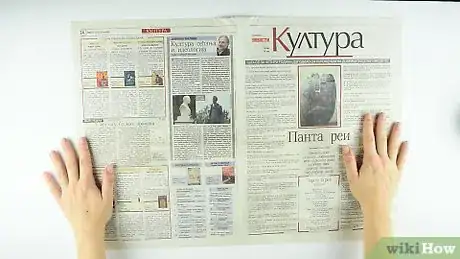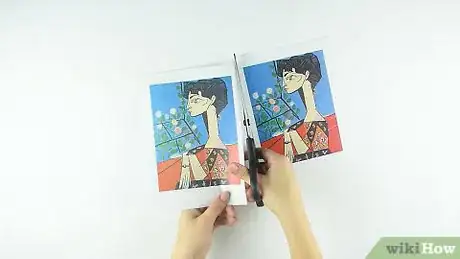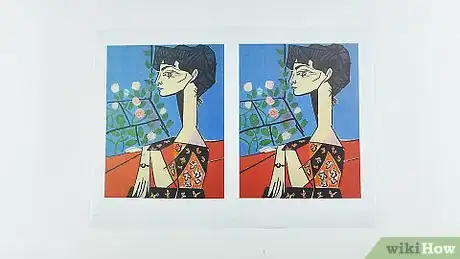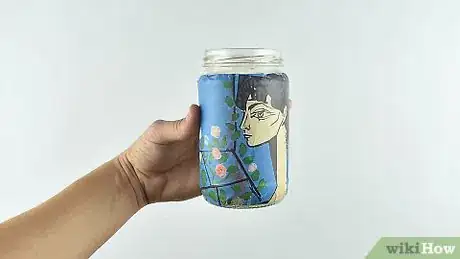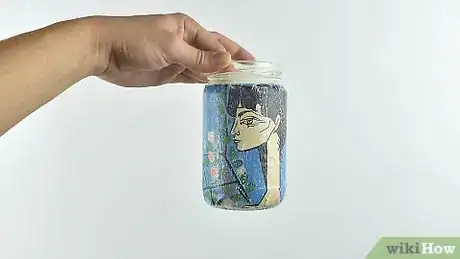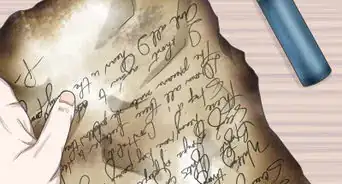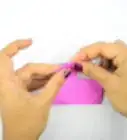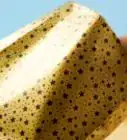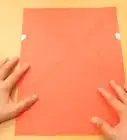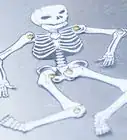This article was co-authored by Nicole Bolin and by wikiHow staff writer, Amy Bobinger. Nicole Bolin is a Crafting Specialist and the CEO of Stencil, a DIY Craft Studio in Phoenix, Arizona. Nicole specializes in interior design and various craft and DIY projects. Nicole holds a Certificate in Interior Design from the New York Institute of Art and Design. She opened Stencil in 2017 to teach others to create DIY projects that fit their home and lifestyle.
There are 7 references cited in this article, which can be found at the bottom of the page.
This article has been viewed 74,658 times.
Decoupage, or the art of gluing paper to a surface to create a new design, is a great way to upcycle a glass object. Whether you want to make a one-of-a-kind flower vase for your room or you're thinking of decorating jars for a holiday gift, this is an easy craft project that anyone can do. The only limit to what you can create is your own imagination!
Steps
Prepping Your Space and Supplies
-
1Lay a craft mat or newspapers on your work surface to protect it. If you want to protect your table, desk, or countertop from getting covered with glue, it's a good idea to put down a protective layer before you get started with your project. A craft mat is a great way to protect any work surface, but layers of newspaper will work if you don't have a mat.[1]
- You could also tear a trash bag along 2 of the seams and lay it down if you don't have any newspaper or a craft mat.
-
2Clean the glass item with soap and water, then alcohol. Dust, debris, and oils from your skin can all interfere with how well the glue will stick to your item. To avoid this, wash the piece you want to decorate with soap and water, then dry it with a lint-free cloth. Wipe the surface of the glass with an alcohol pad and let it dry again.[2]
- If you don’t have any alcohol pads, apply a little rubbing alcohol onto a lint-free cloth and wipe down the glass. Don’t use a cotton ball, which could leave fibers on the surface on the glass.
- Make sure to remove any stickers or labels from the glass before you clean it, and make sure no residue is left behind.[3]
Advertisement -
3Choose and cut out your images. When it comes to decoupage, there’s no right or wrong. If you like a design, you can use it! You can choose several smaller pieces to put together, you can opt to lay down one larger sheet, or you can layer multiple pieces with a background—whatever works for you. Once you decide what you want to use, cut out the image to fit the glass.[4]
- If you’re decoupaging a curved piece of glass, remember to account for the curve when you’re deciding what size to cut your paper.
- Avoid using glossy images, like magazine pages. The coating on the paper can cause the image to bleed when you apply the glue.[5]
Tip: Try using colorful napkins, scrapbook paper, tissue paper, gold leaf, pages from a book, or even scraps of patterned fabric!
-
4Make laser printer copies if you only have 1 copy of your artwork. When you apply the wet decoupage glue to your paper, it will become fragile, and it may tear. If you only have 1 copy of your paper, a small tear could ruin your whole project. If you make a copy of the image, you can just start over if you make a mistake.[6]
- An image from a laser printer is less likely to bleed than one from an inkjet printer.
- Also, if you’re using vintage images, they may not accept glue well, so a laser copy will actually adhere to the glass better.
- If your only option is to use an inkjet printer, use low-moisture content glue.
Applying the Artwork
-
1Dip a 3⁄4 in (1.9 cm) craft brush in water, then the glue. Decoupage glue can sometimes be difficult to spread over a non-porous surface like glass. To thin it out a little, dip your craft brush into a bowl of water, then dip it into the glue.[7]
- If you’re using decoupage glue specifically for a non-porous surface, you may not need to thin it out. Try a little on the glass. If it goes on smoothly, you can apply it as-is.
- You can either dip the brush directly into the glue container, or you can pour a small amount of the glue onto a shallow plate or bowl if you prefer.
- You can find decoupage glue anywhere that craft supplies are sold. Mod Podge is the most popular glue used for decoupage, but other brands will work as well. You could even use Elmer's glue thinned out with water in a pinch.[8]
-
2Brush a thin layer of the glue onto the artwork. Make sure to spread the decoupage glue all the way to the edges. If you need to, dip the brush into the glue again to make sure you get even, complete coverage.[9]
- For larger pieces, brush the glue onto the glass first, then the artwork.[10]
- Make sure to use thin layers of Mod Podge. Otherwise, the paper may tear.[11]
- If you’re using more than one piece of paper, put them on one at a time. Allow each one to dry to avoid tearing them while you’re handling the glass.
Tip: If you want to apply a thick piece of paper to a curved piece of glass, lightly dampen the back of the cardstock first, then brush on the decoupage glue. That will help it form to the shape of the glass better.
-
3Press the artwork against the glass. Begin at one edge, and gently lay your paper or fabric onto the surface of the glass a little at a time. Don’t worry about air bubbles yet, just try to get the paper spread out without any creases, folds, or tears.[12]
- If you're putting the image on the outside of the glass, like around the bottom of a jar, place it face-up. If you want to see the object through the glass, like looking down onto it from the top of a plate, place it face-down.
-
4Add a little extra glue if the paper overlaps anywhere. If your image has wrapped all the way around the outside of the glass, or if you’re overlaying one piece on top of another, use your brush to apply a little extra decoupage glue along the seam. That way, the paper won’t lift up as it’s drying.[13]
-
5Use your fingers or the edge of a flat object to remove any air bubbles. After you have the artwork in place, carefully smooth out any visible air bubbles. For best results, start at the center and work your way out to the edges.[14]
- You can do this with your fingers, or you can carefully glide a flat object like a credit card or rubber brayer along the back of the artwork.[15]
-
6Let it dry for several hours or overnight. Once you’ve applied all of the paper, set it aside to let the glue dry. This is when the paper will be the most fragile, so allow several hours for the glue to set.[16]
- Read the label on your container of decoupage glue for an exact drying time.
Sealing Your Project
-
1Apply another coat of glue or top coat on top of the image. Once the original coat of glue has dried, use your brush to lightly smooth another coat over the entire piece of artwork and the glass around it. Be sure the glue overlaps the edges of the paper all the way around the image you're using, as this is what will seal it permanently into place.[17] [18]
- Some decoupage glue works as both a glue and top coat, in which case you don’t need a separate product. However, other glues require you to use a separate top coat, so read the instructions carefully.
-
2Allow the top coat to dry for at least 1-2 hours between coats. While it doesn’t have to completely finish curing, you do want to give the top coat adequate time to dry. After a few hours, touch the glue in an inconspicuous spot. If it feels tacky to the touch or your finger leaves a print, wait longer before you apply the next coat.[19]
- Read the instructions on the container to determine the exact drying time for your product.
-
3Repeat until you’ve created a smooth surface. The number of coats you’ll need for your project depends on the thickness of the paper or fabric you used. Keep covering the glass in decoupage top coat until the artwork feels like it is flush with the glass.[20]
- Let the project dry again overnight once you’ve added your final coat. Depending on the glue and top coat you used, you may need to let the glass cure for several days.
- Unless you used a water-proof glue, do not submerge the finished item in water. Instead, use a damp cloth to clean only the glass surface.
Expert Q&A
Did you know you can get expert answers for this article?
Unlock expert answers by supporting wikiHow
-
QuestionCan you use Mod Podge on glass?
 Nicole BolinNicole Bolin is a Crafting Specialist and the CEO of Stencil, a DIY Craft Studio in Phoenix, Arizona. Nicole specializes in interior design and various craft and DIY projects. Nicole holds a Certificate in Interior Design from the New York Institute of Art and Design. She opened Stencil in 2017 to teach others to create DIY projects that fit their home and lifestyle.
Nicole BolinNicole Bolin is a Crafting Specialist and the CEO of Stencil, a DIY Craft Studio in Phoenix, Arizona. Nicole specializes in interior design and various craft and DIY projects. Nicole holds a Certificate in Interior Design from the New York Institute of Art and Design. She opened Stencil in 2017 to teach others to create DIY projects that fit their home and lifestyle.
Crafts & DIY Specialist Yes, you can. The trick is to use only thin layers of glue. If you're putting a photo on the jar and know you'll need to move it around, put a layer of Mod Podge on the glass and the back of the photo. This will prevent the paper from tearing as you slide it around. The other important thing is to make sure the pictures and jar are totally dry before applying a second coat of Mod Podge. Otherwise, the pictures will get too wet and tear.
Yes, you can. The trick is to use only thin layers of glue. If you're putting a photo on the jar and know you'll need to move it around, put a layer of Mod Podge on the glass and the back of the photo. This will prevent the paper from tearing as you slide it around. The other important thing is to make sure the pictures and jar are totally dry before applying a second coat of Mod Podge. Otherwise, the pictures will get too wet and tear. -
QuestionHow do I make stained glass?
 Community AnswerHere is a great article to help you get started: How to Make Stained Glass.
Community AnswerHere is a great article to help you get started: How to Make Stained Glass. -
QuestionDo any decoupage on glass need to be heated and put inside the oven?
 Community AnswerOven curing is not required but is very useful between coats, or if you don't have an ideal curing environment. According to Patti Elhoff, author of Upcycle with Decoupage, as well as in my experience, most decoupage glues will tolerate 175 degrees F. Place in a cold oven; once it reaches 175ºF, turn off the oven. Keep the oven door closed for 1 hour. This definitely works with paper and napkins. I would hesitate to use for photos or anything plastic.
Community AnswerOven curing is not required but is very useful between coats, or if you don't have an ideal curing environment. According to Patti Elhoff, author of Upcycle with Decoupage, as well as in my experience, most decoupage glues will tolerate 175 degrees F. Place in a cold oven; once it reaches 175ºF, turn off the oven. Keep the oven door closed for 1 hour. This definitely works with paper and napkins. I would hesitate to use for photos or anything plastic.
Things You'll Need
- Glass item (plate, jar, window, etc)
- Soap and water
- Lint-free cloth
- Alcohol pad
- Scissors
- Artwork
- Decoupage glue
- 3⁄4 in (1.9 cm) craft brush
- Decoupage top coat (if your glue requires one)
References
- ↑ https://artsycraftsymom.com/how-to-upcycle-glass-jars-decoupage-diy-tutorial/
- ↑ https://artsycraftsymom.com/how-to-upcycle-glass-jars-decoupage-diy-tutorial/
- ↑ https://www.thriftyfun.com/Decoupaged-Glass-Vases-2.html
- ↑ https://runningwithsisters.com/how-to-decoupage-a-glass-jar-with-mod-podge/
- ↑ https://www.favecrafts.com/Techniques/How-to-Decoupage
- ↑ https://www.vogue.com/article/john-derian-decoupage-diy-secrets-tips-how-to
- ↑ https://www.vogue.com/article/john-derian-decoupage-diy-secrets-tips-how-to
- ↑ Nicole Bolin. Crafts & DIY Specialist. Expert Interview. 29 October 2020.
- ↑ https://www.thriftyfun.com/Decoupaged-Glass-Vases-2.html
- ↑ Nicole Bolin. Crafts & DIY Specialist. Expert Interview. 29 October 2020.
- ↑ Nicole Bolin. Crafts & DIY Specialist. Expert Interview. 29 October 2020.
- ↑ https://www.pillarboxblue.com/personalised-map-decoupage-glass-tray/
- ↑ https://www.thriftyfun.com/Decoupaged-Glass-Vases-2.html
- ↑ https://www.pillarboxblue.com/personalised-map-decoupage-glass-tray/
- ↑ https://www.favecrafts.com/Techniques/How-to-Decoupage
- ↑ https://www.favecrafts.com/Techniques/How-to-Decoupage
- ↑ Nicole Bolin. Crafts & DIY Specialist. Expert Interview. 29 October 2020.
- ↑ https://www.pillarboxblue.com/personalised-map-decoupage-glass-tray/
- ↑ https://www.favecrafts.com/Techniques/How-to-Decoupage
- ↑ https://www.thriftyfun.com/Decoupaged-Glass-Vases-2.html
About This Article
To decoupage on glass, start by cleaning the glass thoroughly and cutting out the images you want to use. Next, dip a craft brush in the glue and brush a thin layer onto your images. Then, press the artwork against the glass and use your fingers or the edge of a flat object to remove any air bubbles. Finally, let the glue dry for several hours or overnight. To create a smooth surface and seal your design, brush additional coats of glue on top until you're happy with the way your project looks. To learn more about sealing your design, read on!
